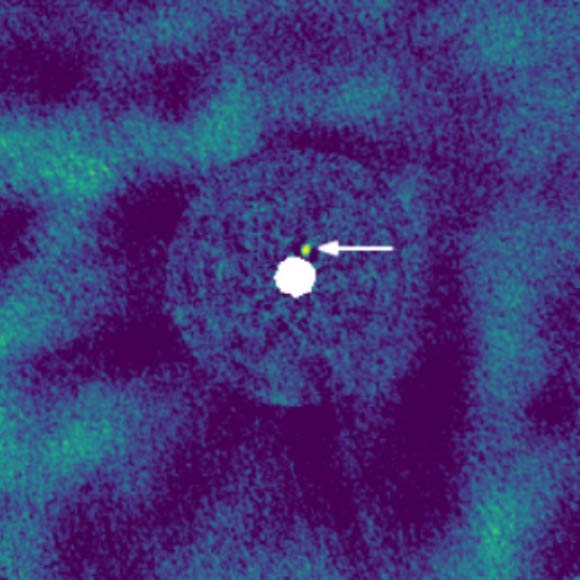Using a combination of the Subaru Telescope, the W. M. Keck Observatory, ESA’s Gaia mission, astronomers have imaged a brown-dwarf companion around the M-dwarf star LSPM J1446+4633.

NIRC2 image of J1446 taken in August 2023; the white arrow indicates the location of the new companion J1446B. Image credit: Uyama et al., doi: 10.3847/1538-3881/ae08b6.
LSPM J1446+4633 (hereafter J1446) is one of the nearby mid-M dwarfs at a distance of 17 parsecs (55 light-years).
The newly-discovered brown dwarf orbits the star at a distance roughly 4.3 times the Earth-Sun separation, completing one orbit in about 20 years.
Named J1446B, the object has a mass between 20 and 60 times the mass of Jupiter.
“The key to this discovery was the combination of three complementary observational techniques: (i) radial velocity (RV) measurements from long-term infrared spectroscopic monitoring with Subaru’s IRD instrument, (ii) high-resolution near-infrared imaging with the W. M. Keck Observatory using advanced adaptive optics with a pyramid wavefront sensor, and (iii) precise astrometric acceleration measurements from ESA’s Gaia mission,” said California State University astronomer Taichi Uyama and colleagues.
“By integrating these datasets and applying Kepler’s laws, we were able to determine the dynamical mass and orbital parameters of J1446B with unprecedented accuracy.”
“Radial velocity data alone cannot break the degeneracy between mass and orbital inclination, but adding direct imaging and Gaia astrometry resolves this ambiguity.”
“The Subaru IRD-SSP program provided essential RV data, while Keck’s state-of-the-art adaptive optics enabled the direct detection of the companion at a very small separation from its host star.”
“Previous studies have demonstrated the power of combining Hipparcos and Gaia astrometric acceleration with direct imaging to detect and characterize companions.”
“However, Hipparcos was unable to measure the positions of faint red dwarfs like J1446.”
“Our study is the first to apply Gaia-only acceleration data to such a system, successfully constraining the orbit and dynamical mass of a brown dwarf companion.”
The near-infrared observations of J1446B revealed brightness variations of about 30%, suggesting dynamic atmospheric phenomena such as clouds or storms.
“The discovery provides a critical benchmark for testing brown dwarf formation scenarios and atmospheric models,” the astronomers said.
“Future spectroscopic observations may even allow researchers to map the weather patterns of this intriguing object.”
“The result highlights the power of combining ground-based and space-based observatories to uncover hidden worlds beyond our Solar System.”
The team’s paper was published in the Astronomical Journal.
_____
Taichi Uyama et al. 2025. Direct Imaging Explorations for Companions from the Subaru/IRD Strategic Program II; Discovery of a Brown-dwarf Companion around a Nearby Mid-M-dwarf LSPM J1446+4633. AJ 170, 272; doi: 10.3847/1538-3881/ae08b6







